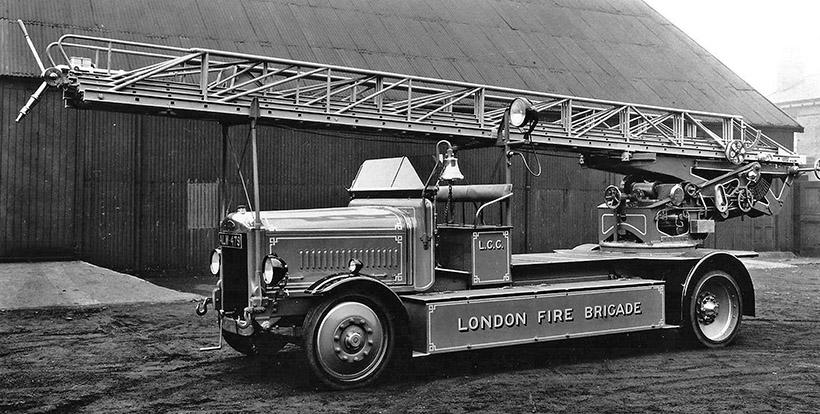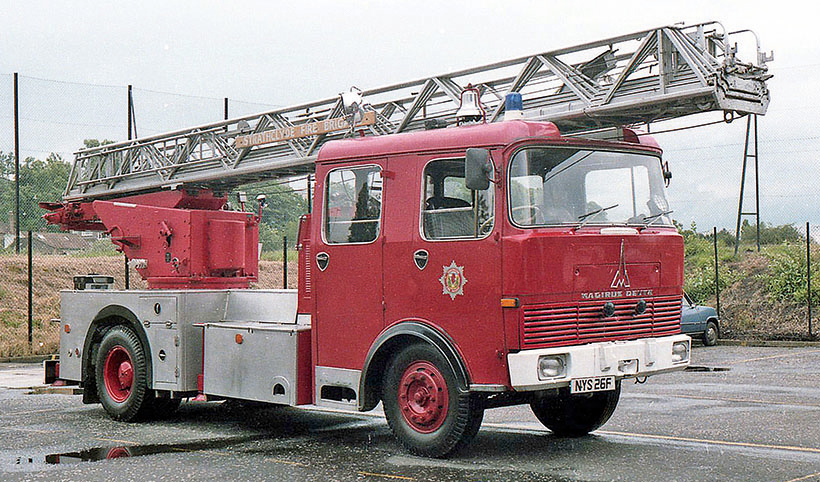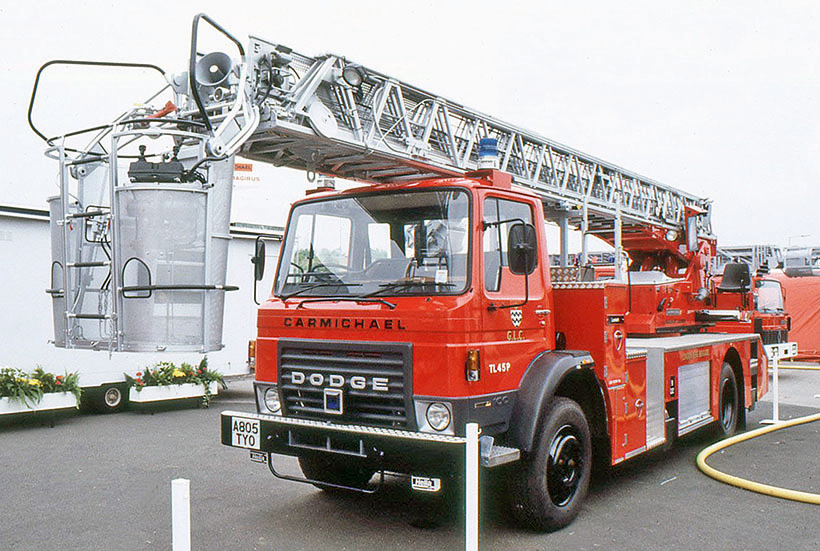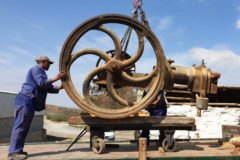The history of turntable ladders
Posted by Chris Graham on 7th January 2021
Ron Henderson recounts the development of turntable ladders, and how the UK fire-fighting market was dominated by a German manufacturer.

The United Kingdom’s first, all-steel turntable ladder, powered by the vehicle’s Magirus road engine, via a power take-off. The three main operations of the 85-foot ladder – rotation, elevation and extension – could all be carried out simultaneously. This was the forerunner of all future ladder developments from German manufacturer, Magirus.
In Britain, there was only ever one maker of motorised turntable ladders for fire-fighting purposes; Merryweather & Sons Ltd, of Greenwich. Its products were sold globally but, in the UK market, this company didn’t have the sole monopoly for its ladders.
Across the North Sea in Germany, there were two notable makers of turntable ladders and other fire engines – Conrad Dietrich Magirus and Carl Metz. Both companies supplied British fire brigades with turntable ladders, in direct competition with Merryweather’s products.

From the 1920s, the combination of the products from John Morris and Dennis Bros, of Guildford, formed the basis of Magiruses UK ladders, until World War Two intervened. This London Fire Brigade ladder, on a Dennis chassis, was delivered in 1934, and remained in service for almost 30 years.
Magirus arrives
The firm of Magirus was established in 1864, when Conrad, a volunteer fire-fighter with the Ulm fire service, recognised the inadequate methods used at the time to fight fires and, consequently, founded a wholesale and retail business offering everything to fight a fire. From this small beginning, the firm graduated to constructing wheeled ladders and hand-pumps, producing its first wheeled ladder in 1872. Its first turntable ladder, mounted on a four-wheeled, horse-drawn carriage and fitted with an 82-foot ladder, followed 20 years later.

This was one of the last Magirus ladders delivered before World War Two. It went to Halifax County Borough in 1936, and was replaced in 1960 by a more up-to-date, hydraulically-operated ladder mounted on an AEC Mercury chassis.
The first UK, turntable ladder was adopted by Manchester Fire Brigade in 1904. Early ladders like this were constructed of wood, and were elevated by carbon dioxide gas that was stored in cylinders mounted on the chassis frames. Also in 1904, Magirus introduced the world’s first engine-driven turntable ladder, when steam took over from the horses.
Two years later, the internal combustion engine was first used to drive the ladder mechanism, via dynamos and electric motors. Then, in 1916, technological advances meant the ladders could be operated directly from the road engine – via a power take-off – with all controls being located on a central plate. The first one, with a length of 85 feet, was commissioned by Glasgow Fire Brigade in 1922. This machine was the forerunner of all future Magirus turntable ladders.

One of the Bedford SL machines fitted with a Magirus ladder. Dinky Toys produced a model of this style of machine. Delivered to Bootle Fire Brigade, Merseyside, in 1957, the scroll legend on the doors was unique to Bootle’s fire engines.
From the earliest days of the company’s turntable ladder production, British fire brigades were regular supporters of Magirus ladders, both horse-drawn and later self-propelled on electrically-driven chassis. Several were adopted by the London Fire Brigade.
John Morris & Sons of Salford was the appointed UK agent for Magirus ladders and, by 1913, was supplying ladders mounted on Belsize chassis, with examples going to Belfast and Leicester, as well as to overseas brigades in China and South Africa.

Only three fire authorities commissioned Leyland Beaver-John Morris-Magirus turntable ladders. This one, which still survives, was one of two commissioned by West Riding of Yorkshire Fire Brigade, in 1954, for Keighley Fire Station. The other two customers for Beaver-mounted ladders were the fire brigades of Belfast and Hong Kong.
By the 1930s, steel was replacing the wooden construction for ladders, with the first British, all-steel version going to the London Fire Brigade in 1932. Thereafter, Magirus motor-driven turntable ladders had a big foothold in the UK but, as well as facing competition from Merryweather & Sons, another German company – Carl Metz – also gained a major foothold in the UK.
John Morris continued with its agency agreement with Magirus, but was now mounting the ladders on Dennis chassis, and offering them with inbuilt pumps. By the end of the 1930s, there were 25 British fire brigades operating Magirus ladders.

Glasgow Fire Service operated turntable ladders from all three major manufacturers – Merryweather, Magirus and Metz. The service made history in 1968, when it ordered seven, air-cooled Deutz chassis, equipping four as conventional pumping appliances and fitting three with Magirus ladders. (Pic: G Parkinson)
War declared!
When war was declared in 1939, this promptly stopped the import of any further pieces of German equipment, by which time there were 48 Magirus ladders in service in the UK, compared with 52 from Metz and just 39 from the UK’s domestic producer, Merryweather & Sons. Up to the end of the Second World War, Merryweather ladders were to dominate the UK, owing to a large number of the company’s ladders being ordered by the Government, under wartime measures.
Peace returned in 1945, and the 40 Magirus ladders that had survived the war were returned to Britain’s re-constituted county and county borough fire authorities. Then the Magirus agency was awarded to David Haydon & Sons of Birmingham.
Post-war, Haydns offered Magirus ladders on Bedford SL petrol-driven chassis while, for those authorities that were changing over to diesel-powered vehicles, Leyland Beaver chassis were offered.

At one time, the post-war fleet of London Fire Brigade turntable ladders consisted wholly of Merryweather equipment, mounted on AEC Mercury chassis. Despite Merryweather’s factory being at Greenwich, the brigade chose German Magirus for its next range of turntable ladders. This Dodge G1613, pictured at the 1984 International Fire Exhibition in Birmingham, was one of eight acquired by London Fire Brigade. This is a rare image, as the vehicle was re-registered ‘B545 WYO’, before being placed into service at Lambeth Fire Station.
The Bedford appliances were smart-looking machines, and readers may recall that Dinky Toys made a nice model of the vehicle. Birmingham, Bootle, Buckinghamshire, Kent and Lancashire operated this type of vehicle, also adopting the later Bedford KGL chassis. Of the diesel-powered Leyland Beavers, only three were sold to UK authorities, with two for West Riding of Yorkshire Fire Brigade and one for Belfast.
A few ladders were also supplied on Commer chassis for Buckinghamshire, Carlisle, Kent, Warwickshire and the South Western Area of Scotland Fire Brigade. Thereafter, the ladders were available from Haydon on any chassis of the buyer’s choice, with AEC, Leyland and Dennis chassis being used. In the 1970s, Carmichael & Sons of Worcester became the UK agent, and supplied many ladder sets on Dennis, Dodge and Shelvoke chassis.
Merryweathers was still in production, but had fallen by the wayside, as far as its turntable ladders were concerned. This left Magirus as the main supplier; an ominous sign for the future of Britain’s fire engineering firms. Merryweather is no more, but Metz and Magirus continue to thrive and, although turntable ladders have mainly been replaced by articulating hydraulic platforms, the German firms are still important contributors to Britain’s fire service inventory.
For a money-saving subscription to Vintage Roadscene magazine, simply click here





